The “new story” of decentralized computers: Will Quilibrium be the next ICP?
Source: CoinGecko, data as of June 23, 2024
Source: Quilibrium
By: Lydia Wu, Researcher at Mint Ventures
*Readers should be aware that since Quilibriums mainnet has not yet been released and there is little public information, the description of the incentive mechanism, economic model, financing history, roadmap, etc. in this article is only based on the current time point, and the actual situation may change in the future. This article is mainly written for research and popular science purposes, please do not use it as an investment reference, and we also welcome criticism and discussion from peers.
1. Report highlights
1.1 Core investment logic
-
Quilibrium attempts to find a balance between the computing power of the traditional Internet and the decentralization of blockchain, and has designed a unique decentralized cloud computing architecture for this purpose.
-
Quilibrium has built a database-based operating system that is closer to traditional software in terms of development experience. It may attract more traditional software developers and facilitate current Web3 developers to build more complex encryption applications.
-
Quilibrium’s design emphasizes security and privacy, which is very attractive to companies that do not want to expose sensitive data but want to use encryption technology. For individuals, Farcaster’s initial breakthrough also proves the long-term potential of decentralized applications in acquiring users and generating revenue.
-
Founder and CEO Cassie Heart is a former senior engineer at Coinbase and developer at Farcaster. The team has rich experience, stable delivery capabilities and distinctive personalities.
1.2 Main risks
-
The project is in a very early stage, the main network has not yet been released, and the project is relatively complex. The verification of technical feasibility and market demand has not yet been completed.
-
In the short term, it may face competition from the more well-known Arweave AO in terms of user minds and developers.
-
There is no fixed token model, and the token release rate may be unstable, which increases certain risks for investors.
1.3 Valuation
Since Quilibrium is still in a very early stage, we cannot get an accurate valuation of the project for the time being. However, from the perspective of circulating market value and total circulating market value, compared with other market players with overlapping concepts, Quilibriums current market value is attractive.
2. Business Analysis
Quilibrium positions itself as a decentralized Internet layer protocol that provides the convenience of cloud computing without sacrificing privacy or scalability and a decentralized PaaS solution. In view of this positioning, this section will explain Quilibriums business around the following questions.
-
What are the problems with traditional Internet cloud computing?
-
Why do we need (yet another) decentralized computer?
-
What is special about Quilibrium compared to the current mainstream blockchain design?

Source: Cassie Hearts Farcaster account
2.1 Business Positioning
2.1.1 Let’s start with calculation
Whether in Web2 or Web3, computing is a crucial concept and the power source for application development, execution, and expansion.
In the traditional Internet architecture, computing tasks are usually completed by centralized servers. The emergence of cloud computing has improved the scalability, accessibility, and cost efficiency of computing, and has gradually replaced traditional computing to become the mainstream.
From the perspective of service content, the cloud service models provided by large cloud service providers can generally be divided into three categories: Infrastructure as a Service (IaaS), Platform as a Service (PaaS) and Software as a Service (SaaS), which correspond to entities with different needs and capabilities and provide different levels of control over resources. SaaS is generally more familiar to end users. PaaS and IaaS are mainly for developers.

Source: Lydia @ Mint Ventures
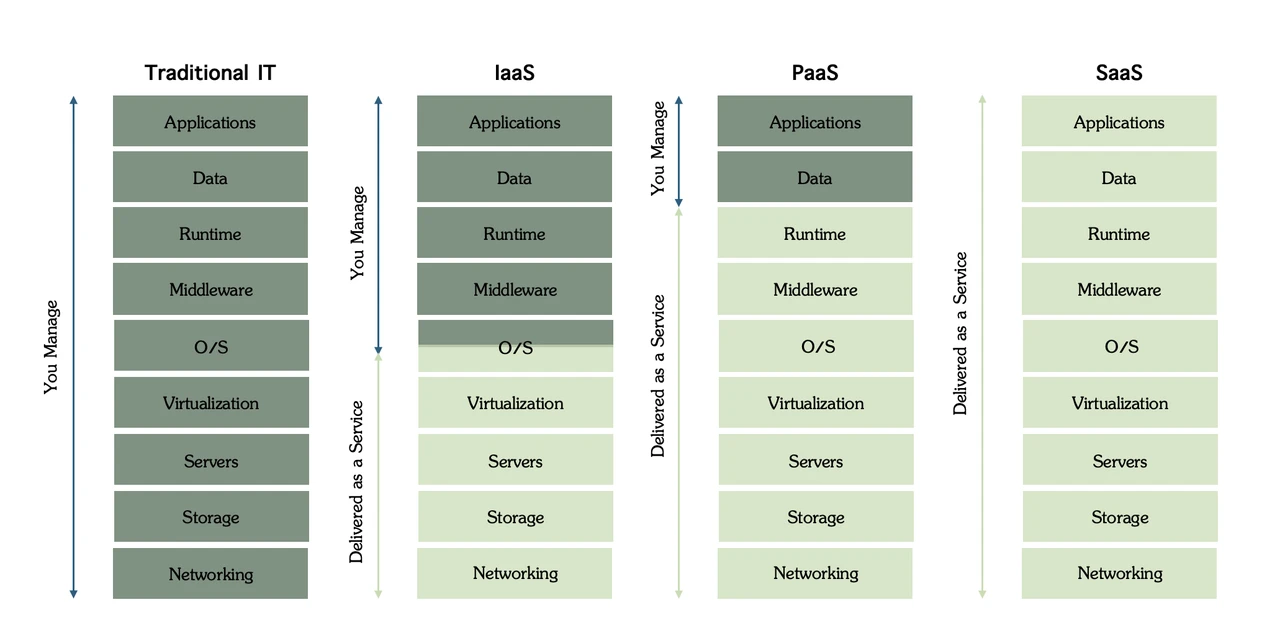
Source: S2Lab, Lydia @ Mint Ventures
In mainstream blockchains such as Ethereum, computing is usually done by decentralized nodes. This approach does not rely on centrally controlled servers. Each node performs computing tasks locally and ensures the correctness and consistency of data through a consensus mechanism. However, the capacity and processing speed of decentralized computing are usually not comparable to traditional cloud services.
Quilibrium attempts to find a balance between the computing power and scalability of the traditional Internet and the decentralization of blockchain, opening up new possibilities for application development.

Source: Cassie Hearts live streaming screen
2.1.2 Centralization Problem of Computer Systems
For most end users, the problem of computer centralization is not easy to perceive. This is because end users are mostly directly facing computer systems at the hardware level. Our PCs, mobile phones and other devices are scattered all over the world and run independently under personal control. This distributed physical existence makes the computer system not necessarily centralized at the hardware level.
In contrast to the relatively decentralized hardware, existing computer systems are significantly more centralized in terms of network architecture and cloud computing services. Amazon AWS, Microsoft Azure, and Google Cloud accounted for more than 67% of the cloud service market share in the first quarter of 2024, creating a significant gap with latecomers.
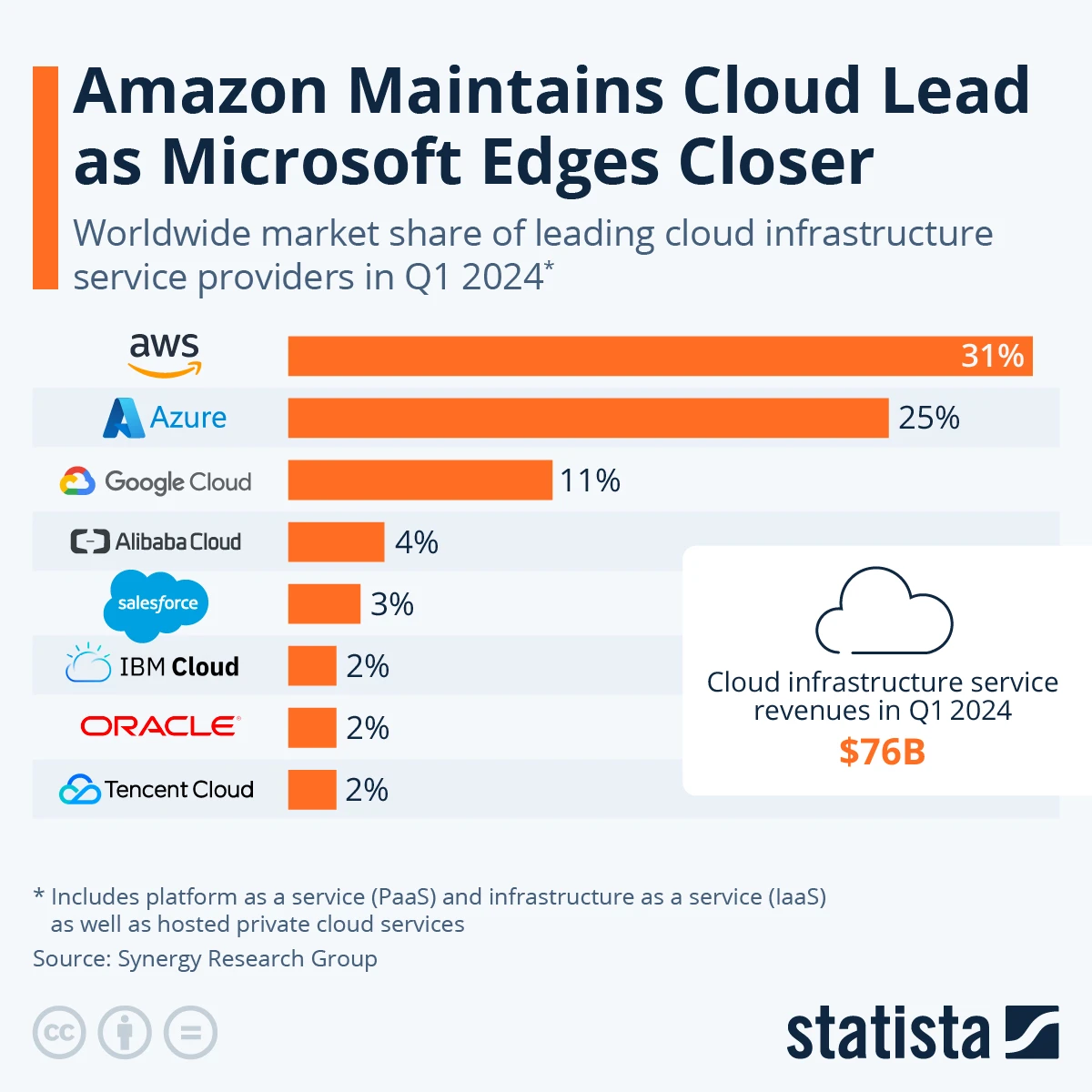
Source: Synergy Research Group
Moreover, as the water seller of the AI wave, the trend of cloud service providers getting stronger and stronger seems to continue. As the exclusive cloud service provider of OpenAI, Microsoft Azures performance growth rate in the past year has changed from the previous decline to an accelerated growth trend. In Microsofts third quarter of fiscal year 2024 (i.e. the first quarter of the natural year 2024) financial report, the revenue of Azure and other cloud services increased by 31%, higher than the market expectation of 28.6%.
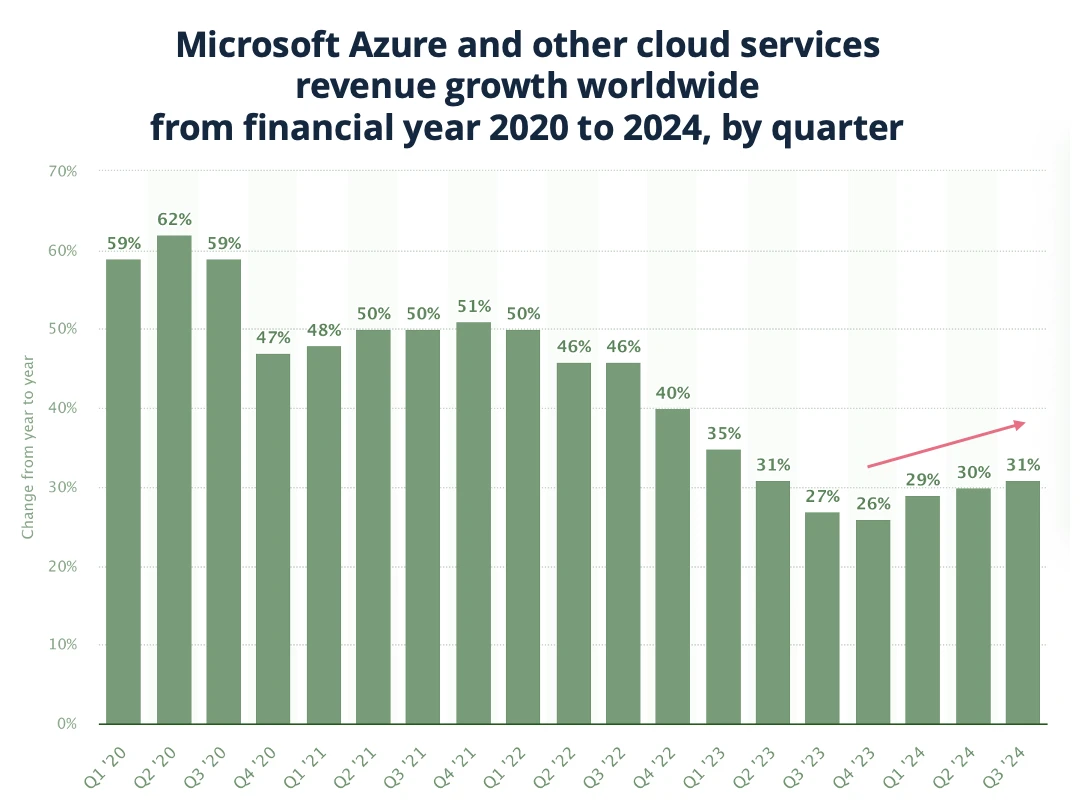
Source: Microsoft, Lydia @ Mint Ventures
In addition to market competition considerations, privacy and security issues brought about by centralized computer systems are also gaining more and more attention. Every outage of several large cloud service providers will have a wide-ranging impact. Data shows that from 2010 to 2019, AWS has experienced 22 sudden failures, with an average of 2.4 failures per year. In addition to the impact on Amazons own e-commerce business, the network services of companies such as Robinhood, Disney, Netflix, and Nintendo that use AWS have also been interrupted on a large scale.
2.1.3 The Proposal of Decentralized Computer
In this context, the necessity of decentralized computers has been repeatedly raised. In recent years, as centralized cloud service providers have increasingly adopted distributed architectures, avoiding single points of failure by replicating data and services in multiple locations, and improving performance through edge storage, the narrative focus of decentralized computing has gradually shifted to data security, privacy, scalability, and cost-effectiveness.
Let us first analyze the concepts of decentralized computers proposed by several different projects. Their common feature is that they hope to build a global distributed computing platform through decentralized data storage and processing to support the development of decentralized applications.
-
World Computer: Generally refers to Ethereum, which provides a global smart contract execution environment. Its core function is decentralized computing and global unified execution of smart contracts.
-
Internet Computer: Generally refers to the ICP developed by the Dfinity Foundation, which aims to expand the functionality of the Internet and enable decentralized applications to run directly on the Internet.
-
Hyper Parallel Computer: Generally refers to the AO protocol proposed by Arweave, which is a distributed computing system based on the Arweave network, characterized by high parallelism and high fault tolerance.
It is worth noting that ICP, AO and Quilibrium are not blockchains in the traditional sense. They do not rely on a linear block arrangement structure, but maintain the core principles of blockchain such as decentralization and data immutability, and can be regarded as a natural extension of the scope of blockchain technology. Although ICP has not yet been able to implement its grand plan, the emergence of AO and Quilibrium does bring a new possibility that will affect the future of Web3.
The following table compares the technical features and application directions of the three, in order to help readers understand whether Quilibrium will repeat the mistakes of ICP, and as cutting-edge solutions for decentralized computing, what is the difference between Quilibrium and AO, known as the Ethereum killer.
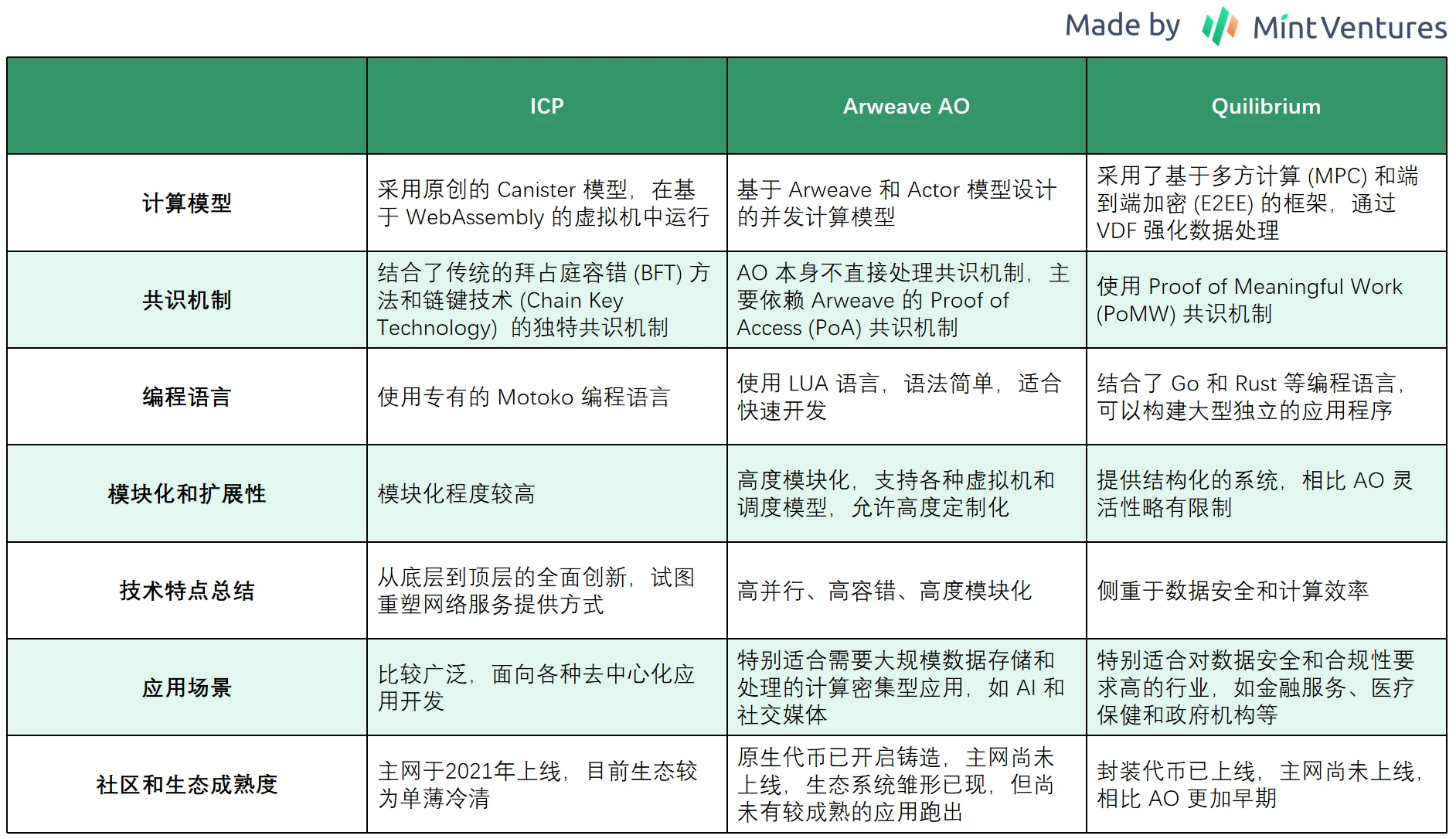
2.2 Consensus Mechanism
In traditional blockchains, the consensus mechanism is at a relatively abstract and core level, which defines how the network reaches consensus, how to process and verify transactions and other operations. Different consensus mechanism choices will affect the networks security, speed, scalability, and degree of decentralization.
Quilibriums consensus mechanism is called Proof of Meaningful Work (PoMW), and miners are required to complete work that is meaningful to the network, such as data storage, data retrieval, network maintenance, etc. The design of the PoMW consensus mechanism integrates multiple fields such as cryptography, multi-party computing, distributed systems, database architecture, and graph theory, aiming to reduce dependence on a single resource (such as energy or capital), ensure the decentralization of the network, and maintain security and scalability while the network scales up.
The incentive mechanism is the key to ensure that the consensus mechanism can run smoothly. Quilibriums incentive allocation is not static, but will be dynamically adjusted according to the network status to ensure that the incentive matches the demand. Quilibrium also introduced a multi-proof mechanism, which allows a node to verify multiple data fragments, and can still maintain network operation when node and core resources are insufficient.
We can use a simplified formula to understand the final benefits of miners, where the unit reward is dynamically adjusted according to the size of the network.
Revenue = score × unit reward
The score is calculated based on a variety of factors, as shown below:

The parameters are defined as follows:
-
Time in Mesh for Topic: The longer the participation time and the higher the stability, the higher the score.
-
First Message Deliveries for Topic: The more first message deliveries there are, the higher the score.
-
Mesh Message Delivery Rate/Failures for Topic: Nodes with high delivery rate and low failure rate are scored higher
-
Invalid Messages for Topic: The fewer invalid messages are delivered, the higher the score
The weighted sum of the above four parameters will have a topic cap (TC), which is used to limit the value within a certain range to avoid unfair scoring caused by excessive values of some parameters.
-
Application-Specific Score: A score defined by a specific application
-
IP Collocation Factor: The fewer nodes from the same IP address, the higher the score.

Source: Quilibrium Dashboard
The number of Quilibrium nodes currently in operation has exceeded 60,000. The actual node income in operation may fluctuate according to the different parameter weights between each version. After version v1.4.19, miners income can be viewed in real time, but they need to wait until the main network is launched before they can be claimed.
2.3 Network Architecture
Quilibriums core business is a decentralized PaaS solution, and its network architecture is mainly composed of communication, storage, data query and management, and operating system. This section will focus on the differences between its design and the current mainstream blockchain. Readers interested in technical details and implementation methods can refer to the official documents and white papers.
2.3.1 Communication
As the basic structure of the network, Quilibriums communication consists of four parts.
a. Key Generation
Quilibrium proposed a PCAS (Planted Clique Addressing Scheme) key generation method based on graph theory. Similar to traditional blockchain technology, PCAS also uses asymmetric encryption – each user has a public key and a private key. The public key can be made public and used to encrypt information or verify signatures; the private key is kept confidential and used to decrypt information or generate signatures. The difference between the two lies mainly in the key generation method, form of expression, and application direction (see the table below).

b. End-to-end encryption
End-to-end encryption (E 2 EE) is a key component to ensure the security of communication between nodes. Only the communicating parties can see the plaintext data, and even the system or intermediary that helps to transmit the information cannot read the content of the information.
Quilibrium uses an end-to-end encryption method called Triple-Ratchet, which provides higher security than the traditional ECDH scheme. Specifically, traditional schemes usually use a single static key or update the key regularly, while the Triple-Ratchet protocol updates the key after each communication, thereby achieving forward secrecy, post-leakage secrecy, arbitrariness, replay protection, and out-of-order message delivery. This scheme is particularly suitable for group communication, but it is relatively complex and computationally expensive.
c. Hybrid network routing
Mixnets are a black box that receives messages from a sender and passes them to a receiver, while an external attacker cannot associate the sender and receiver even if they have access to the information outside the black box.
Quilibrium uses RPM (Random Permutation Matrix) technology, providing a hybrid network architecture that is structurally complex and difficult to crack by external and internal attackers, with advantages in anonymity, security and scalability.
d. Peer-to-peer communication
GossipSub is a peer-to-peer messaging protocol based on a publish/subscribe model, which is widely used in blockchain technology and decentralized applications (DApps). Quilibriums BlossomSub protocol is an extension and improvement of the traditional GossipSub protocol, aiming to improve privacy protection, enhance the ability to resist Sybil attacks, and optimize network performance.
2.3.2 Storage
Most traditional blockchains use cryptographic hash functions as a basic data integrity verification tool and rely on consensus mechanisms to ensure network consistency. Such mechanisms have two major limitations:
-
Usually does not include verification of storage time, and has no direct mechanism to defend against attacks based on time or computing power
-
Storage and consensus mechanisms are usually separated, which may lead to problems with data synchronization and consistency
Quilibriums storage solution uses a verifiable delay function (VDF) design to create a time-dependent chain structure and integrate storage and consensus mechanisms. Combined with the following figure, we can summarize several characteristics of this solution:
-
Input processing: By processing the input using hash functions such as SHA 256 and SHAKE 128, any small change in the data will result in a significantly different hash value, making the data more difficult to tamper with and easier to verify
-
Latency guarantee: The calculation process is deliberately set to be time-consuming. The calculation tasks must be performed in sequence, and each step depends on the result of the previous step. It is impossible to speed up the process by increasing computing resources to ensure that the output is based on continuous and deterministic calculations. Since the generation process cannot be parallelized, any attempt to recalculate or change the already published VDF results will take a considerable amount of time, which provides network participants with enough time to detect and respond.
-
Fast verification: The time required to verify a VDF result is much less than the time required to generate the result. Usually, only some mathematical checks on the final result or some auxiliary data are required to confirm the validity of the result.

Source: Quilibrium Whitepaper
This time-proof chain structure does not rely on the generation of blocks in traditional blockchains, and can theoretically reduce MEV attacks and front-running.
2.3.3 Data Query and Management
Traditional blockchains mostly use simple key-value storage or Merkle Tree to manage data. This structure is usually limited in expressing complex relationships and supporting advanced queries. In addition, most blockchain systems currently do not provide built-in privacy protection mechanisms when nodes execute queries, which is also the background for the introduction of privacy-enhancing technologies such as zero-knowledge proofs.
Quilibrium proposed an Oblivious Hypergraph architecture, which combines the hypergraph structure and the Oblivious Transfer technology to support complex query capabilities while maintaining data privacy. Specifically:
-
Hypergraph structure: allows edges to connect multiple vertices, enhancing the ability to express complex relationships. This structure can directly map multiple database models, allowing any type of data relationship to be expressed and queried on the hypergraph.
-
Bearer transfer technology: Even the nodes processing the data cannot understand the specific data content being accessed, which enhances the privacy protection during the data query process
2.3.4 Operating System
An operating system is not a concept native to blockchain. Most traditional blockchains focus on consensus mechanisms and data immutability, and usually do not provide complex operating system-level functions. For example, although Ethereum supports smart contracts, its operating system functions are relatively simple and are mainly limited to transaction processing and state management.
Quilibrium has designed an operating system based on its Hypergraph database and implemented common operating system primitives such as file systems, schedulers, IPC-like mechanisms, message queues, control key management, etc. This design of building an operating system directly on the database can provide support for the development of complex decentralized applications.
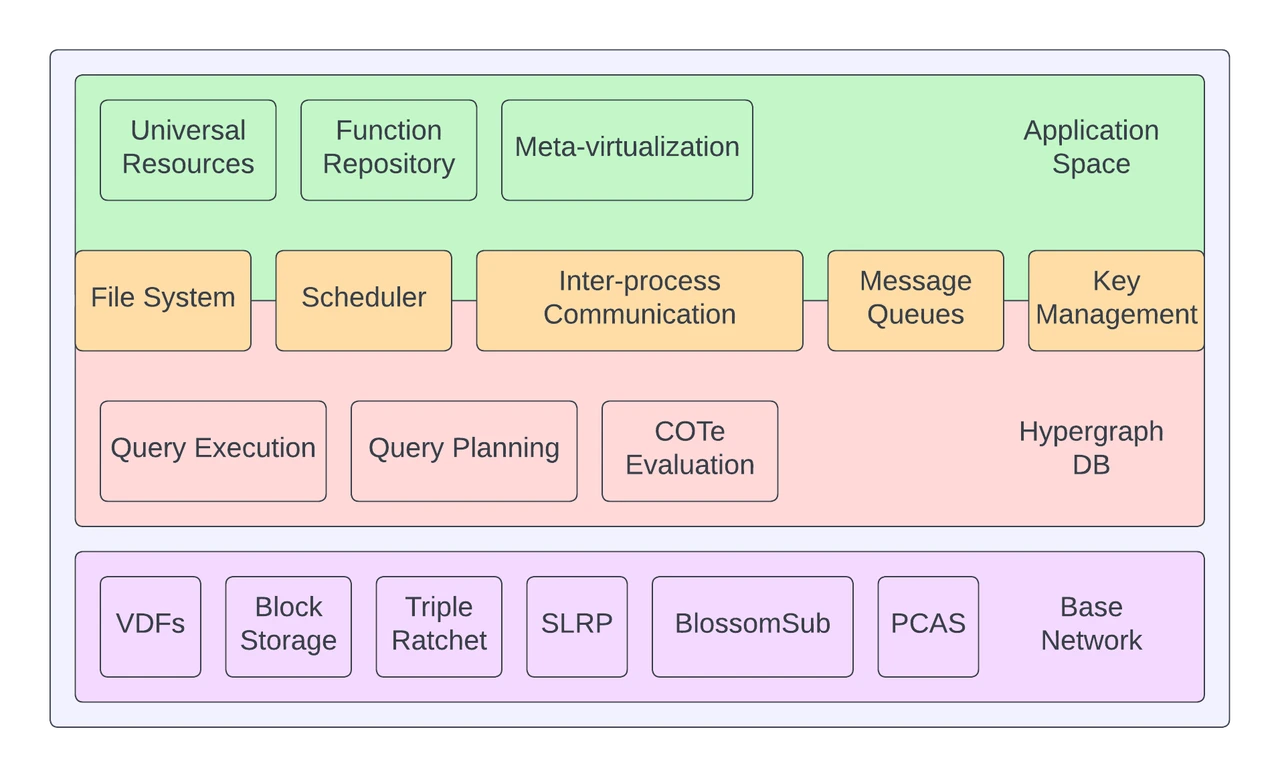
Source: Quilibrium Whitepaper
2.4 Programming Languages
Quilibrium is developed using Go as the main programming language, and is also combined with Rust and JavaScript. The advantages of the Go language lie in its ability to handle concurrent tasks, concise syntax, and active developer community. According to the programming language rankings released by Tiobe, the Go language has risen significantly in recent years and has ranked 7th in the latest June list. Other blockchain projects that also use the Go language for underlying development include Ethereum, Polygon, and Cosmos.

Source: Quilibrium

Source: Tiobe
3. Project Status
3.1 Project History and Roadmap
Quilibriums white paper was released in December 2022, and its roadmap is roughly divided into 3 phases: Dusk, Equinox and Event Horizon.
Quilibrium is still in a very early stage. The team updates the network every two weeks. The latest version is v1.4.20. Since the team deleted the 1.5 phase of the roadmap, the network version 1.4 will be directly upgraded to version 2.0. Version 2.0, also known as the main network, is the end of the Dusk phase and is expected to be officially launched in late July, when $QUIL bridging will be allowed.
According to the tentative plan, the Equinox and Event Horizon phases will provide support for more advanced applications such as streaming media and AI/ML model training.
3.2 Team and Financing
Quilibriums founder/CEO is Cassie Heart. Prior to founding Quilibrium, she was a senior software engineer at Coinbase and has over 12 years of experience in software development and blockchain.
Because Cassie is opposed to centralized social media platforms, she and Quilibriums project account are mainly active on Farcaster. Cassies Farcaster account has more than 310,000 followers, including Ethereum founder Vitalik. Cassie is also a developer of Farcaster.
From the Quilibrium developer data panel, the development of the Quilibrium project started in April 2023 and has been progressing steadily since then. There are 24 developers displayed, with Cassie Heart (Cassandra Heart) as the main developer.


Source: Quilibrium
The Quilibrium team has not yet disclosed its financing history and investor institutions.
3.3 Token Model Analysis
$QUIL is the native token of Quilibrium, which is 100% fair launch, and all token output comes from node operation. The team itself operates a small number of nodes, but owns less than 1% of the tokens.
$QUIL does not have a fixed token model, and the total supply of tokens is uncapped, but it will be dynamically adjusted according to the speed of network adoption – when the network scale increases, more tokens will be released as node incentives; if the scale growth slows down, the corresponding token release rate will also decrease.
The table below is a prediction made by the team and community members on the token release schedule. The current circulation is 340 million, and the final supply is expected to converge to around 2 billion. The specific release situation depends on the development of the ecosystem.

Source: @petejcrypto
3.4 Risks
Quilibriums potential risks at this stage include:
-
The project is in a very early stage, the main network has not yet been released, and the project is relatively complex. The verification of technical feasibility and market demand has not yet been completed.
-
In the short term, it may face competition from the more well-known Arweave AO in terms of user minds and developers.
-
There is no fixed token model, and the token release rate may be unstable, which increases certain risks for investors.
4. Valuation
The valuation of public chain-like infrastructure is itself a very complex process, involving multiple dimensions such as TVL, on-chain active addresses, number of dAPPs, developer community, etc. Quilibrium is still in a very early stage, and Arweave AOs token $AO is not yet open for trading, so we are unable to come up with an accurate valuation of the project for the time being.
We list here the circulating market value and total circulating market value of projects that have a certain degree of conceptual overlap with Quilibrium (data as of June 23, 2024) for your reference.
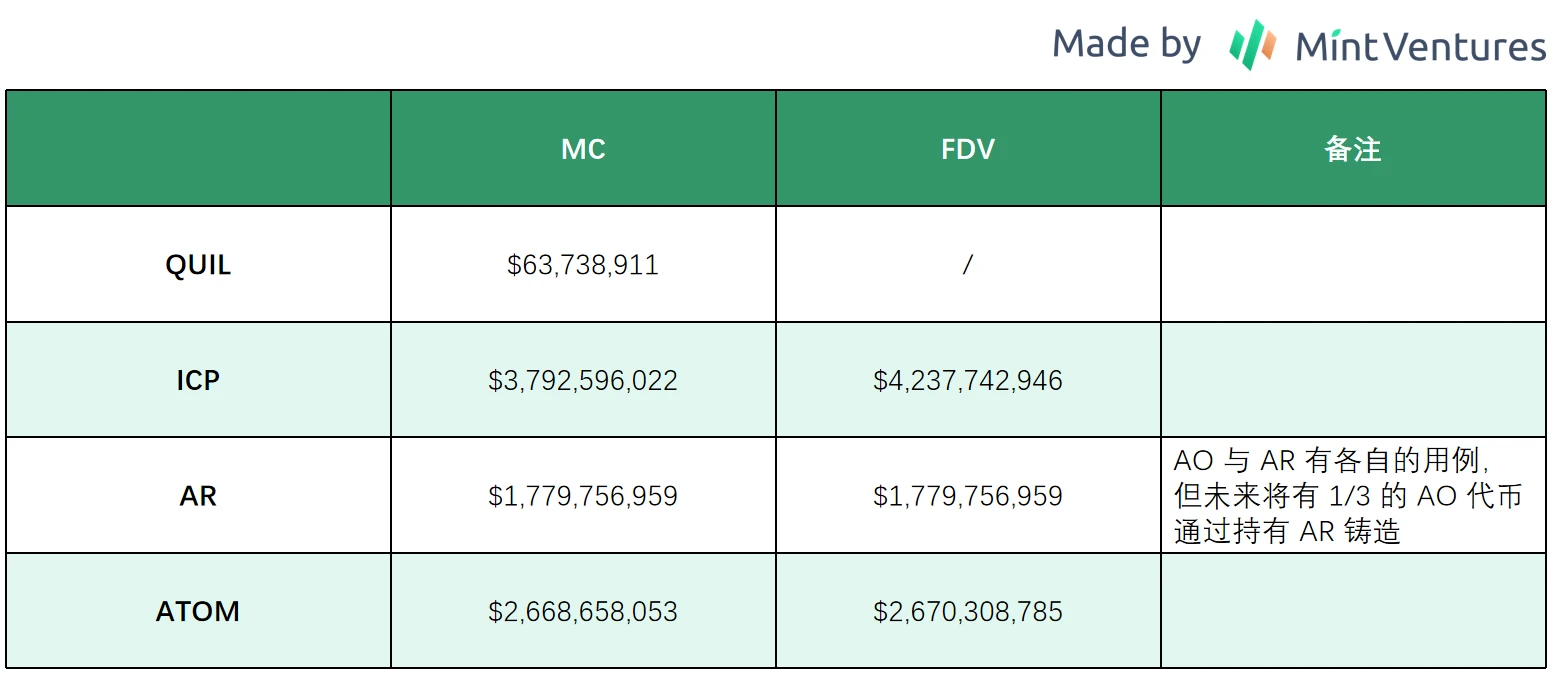
Source: CoinGecko, data as of June 23, 2024
5. References and Acknowledgements
This article was written with thanks to Hai Ge (@PleaseCallMeWhy), Lan Ge, and Connor for their review and comments.
-
https://quilibrium.com/quilibrium.pdf
-
https://paragraph.xyz/@quilibrium.com
-
https://dashboard.quilibrium.com/
-
https://www.youtube.com/watch?v=Ye677-FkgXEab_channel=CassandraHeart
-
https://dune.com/cincauhangus/quilibrium
-
https://source.quilibrium.com/quilibrium/ceremonyclient/-/graphs/main?ref_type=heads
-
https://www.tiobe.com/tiobe-index/
-
https://www.blocmates.com/meal-deal-research-reports/quilibrium-crypto-not-blockchain-long-live-the-internet
-
https://www.statista.com/chart/18819/worldwide-market-share-of-leading-cloud-infrastructure-service-providers/
-
https://s2-labs.com/admin-tutorials/cloud-service-models/
-
https://medium.com/@permadao/%E5%8E%BB%E4%B8%AD%E5%BF%83%E5%8C%96%E4%BA%91%E6%9C%8D%E5%8A%A1%E8%BF%9B%E5%8C%96%E5%8F%B2-%E4%BB%8E-dfinity-ic-%E5%88%B0-arweave-ao-839b09b4f3ff
-
https://www.microsoft.com/en-us/investor/earnings/FY-2024-Q3/press-release-webcast
-
https://x.com/perma_daoCN/status/1798565157435830416
-
https://x.com/Pow2wer/status/1802455254065402106
This article is sourced from the internet: The “new story” of decentralized computers: Will Quilibrium be the next ICP?
At the BitcoinAsia conference in May, Merlin Chain founder Jeff delivered a speech titled From Bitcoin L1 to Merlin Chains Native Innovation, which explored in depth how Merlin Chains native innovation can empower the Bitcoin ecosystem. He reviewed the evolution of the Bitcoin ecosystem and explored in depth how Merlin Chains native innovation will promote the development of the Bitcoin ecosystem. The following is the full text of the speech, compiled based on the on-site recording. Before 2023, Bitcoin was always seen as digital gold for value storage, and no one was creating new concepts and applications around Bitcoin. But after the Ordinals craze in mid-2023, more and more people began to create NFT-related content on the Bitcoin network, issuing assets such as BRC-20, BRC-420, and ORC-20, and then Atomicals…







